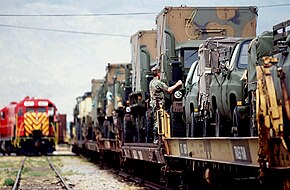
| Part of a series on |
| War (outline) |
|---|
 |
The history of military logistics goes back to Neolithic times. The most basic requirements of an army are food and water. Early armies were equipped with weapons used for hunting like spears, knives, axes and bows and arrows, and were small due to the practical difficulty of supplying a large number of soldiers. Large armies began to appear in the Iron Age. Animals such as horses, oxen, camels and even elephants were used to carry supplies. Food, water and fodder for the animals could usually be found or purchased in the field. The Roman Empire and Maurya Empire in India built networks of roads, but it was far less expensive to transport by sea than by road. After the fall of the Western Roman Empire in the fifth century there was the shift in Western Europe away from a centrally organised army.
Starting in the late sixteenth century, armies in Europe increased in size, to 100,000 or more in some cases. When operating in enemy territory an army was forced to plunder the local countryside for supplies, which allowed war to be conducted at the enemy's expense. However, with the increase in army sizes this reliance on pillage and plunder became problematic, as decisions regarding where and when an army could move or fight became based not on strategic objectives but on whether a given area was capable of supporting the soldiers' needs. Sieges in particular were affected by this, both for an army attempting to lay siege to a town and one coming to its relief. Unless a commander was able to arrange a form of regular resupply, a fortress or town with a devastated countryside could become immune to either operation. Napoleon made logistics a major part of his strategy. He dispersed his corps along a broad front to maximise the area from which supplies could be drawn. Each day forage parties brought in supplies. This differed from earlier operations living off the land in the size of the forces involved, and because the primary motivation was the emperor's desire for mobility. Ammunition could not as a rule be obtained locally, but it was still possible to carry sufficient ammunition for an entire campaign.
The nineteenth century saw technological developments that facilitated immense improvements to the storage, handling and transportation of supplies which made it easier to support an army from the rear. Canning simplified storage and distribution of foods, and reduced waste and the incidence of food-related illness. Refrigeration allowed frozen meat and fresh produce to be stored and shipped. Steamships made water transports faster and more reliable. Railways were a more economical form of transport than animal-drawn carts and wagons, although they were limited to tracks, and therefore could not support an advancing army unless its advance was along existing railway lines. At the same time, the advent of industrial warfare in the form of bolt-action rifles, machine guns and quick-firing artillery sent ammunition consumption soaring during the First World War.
In the twentieth century the advent of motor vehicles powered by internal combustion engines offered an alternative to animal transport for moving supplies forward of the railhead, although many armies still used animals. Air transport provided an alternative to land and sea transport, but with limited tonnage and at high cost. An airlift over "the Hump" helped supply the Chinese war effort during the Second World War, and the 1948 Berlin Air Lift was successful in supplying half of the city. With the subsequent development of large jets, aircraft became the preferred method of moving personnel over long distances, although it was still more economical to move cargo by sea and rail. In forward areas, the helicopter was well-suited to moving troops and supplies, especially over rugged terrain. The increasing complexity of weapons and equipment saw the proportion of personnel devoted to logistics rise. The diversity of equipment and consequent large number of spare parts saw attempts at standardisation but the adoption of foreign weapons also meant the adoption of foreign tactics, and giving up the advantages of bespoke systems tailored to a nation's own, often unique, strategic environment.
